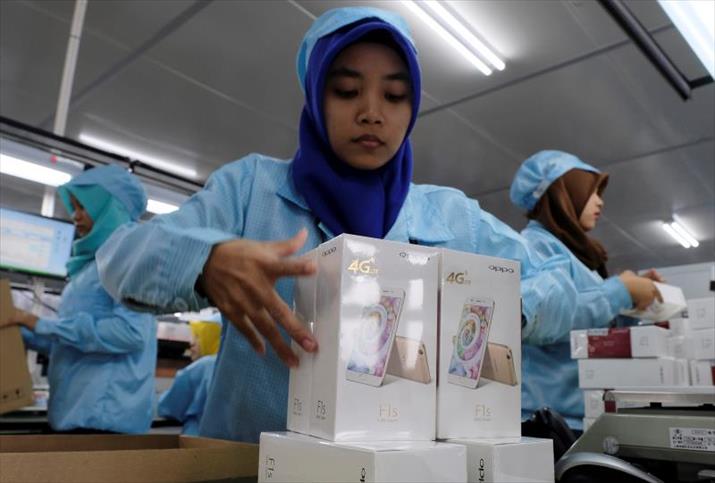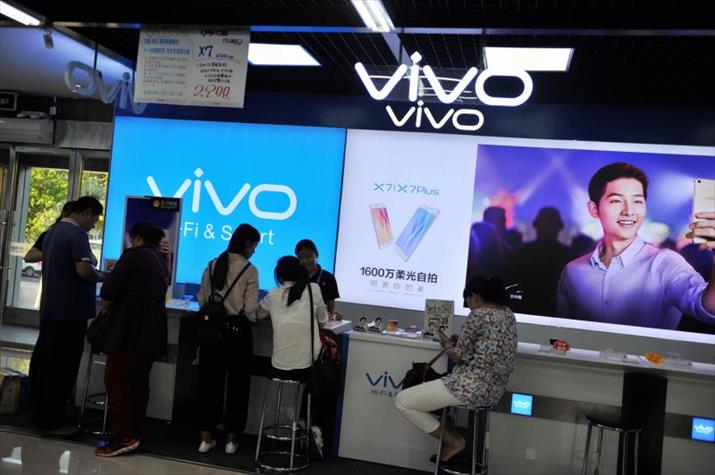| Business |
| Homegrown Giants | |
| China's smartphone makers OPPO and VIVO shake up global competition | |
|
|
 Workers package OPPO F1s smartphones at an OPPO factory in Tangerang, Indonesia, on September 20, 2016 (XINHUA)
China's smartphone arena was dominated by OPPO in 2016—the company stood atop its competitors with 16.8 percent of the market. Started by China's BBK Electronics in 2004, OPPO shipped 78.4 million units in 2016, up 122.2 percent year on year, according to the worldwide Quarterly Mobile Phone Tracker published by research firm International Data Corporation (IDC) in early February. OPPO's sister brand VIVO ranked third, with a shipment volume of 69.2 million units, behind China's telecom equipment giant Huawei. The top three smartphone players, all homegrown, took up 48 percent of the Chinese market. These brands' slice of the market far exceeded Apple's 9.6-percent share. This indicates a growing acceptance of domestic brands—a result of improvements in product features and better marketing messages, said the IDC. Keys to success Before 2016, OPPO and VIVO (O&V) were not regarded as serious contenders in the global smartphone arena. Various factors, such as targeted promotions, extensive offline retail channels, and the pursuit of quality have contributed to their success. A large volume of targeted advertisements helped prop up O&V's popularity. "O&V mainly target a young audience, including employees and students born after the 1980s, especially young ladies," Peng Jianfeng, a professor with Renmin University of China, wrote in an online commentary. Peng added that there is a huge market in that demographic group in China's third- and fourth-tier cities. In an attempt to attract the millennials, O&V invited many top pop stars including TFBOYS—a leading Chinese boy band—to become their brand ambassadors. They also bought the naming rights of several popular TV shows including Hunan TV's Happy Camp, a well-known 20-year-old entertainment program. According to a recent survey conducted by Peng, O&V's advertisements flood 80 percent of outdoor billboards in east China's Jiangsu Province. "Walking around towns flooded with O&V's posters, you may be convinced that O&V are the best smartphone choices," said Peng. An expanding offline retail presence also explains O&V's surging sales. "A key trend that stood out in 2016 was the slowdown of the growth of online channels in China," said the IDC. O&V has invested heavily in physical retail stores in lower-tier cities, unlike competitors such as Xiaomi and Huawei which focus more on online sales. Today O&V have over 200,000 retail outlets throughout the Chinese mainland, which gives customers more access to feel and touch their products. Li Jinfeng, a high school English teacher in Qiongzhong County, south China's Hainan Province, recently bought an OPPO R9s in January at a local brick-and-mortar store not far away from her home. "I was enticed by [OPPO's] advertisements, which can be seen everywhere in town," said Li. "I believe both the handset quality and the after-sales services offered in brick-and-mortar stores are more trustworthy than those seen online." "What's more, O&V are willing to share a higher margin of profit with local retailers, which also support their sales volumes," Jin Di, Research Manager of IDC China, told Beijing Review. Nonetheless, some doubt the strategy's feasibility, claiming that heavy investment in advertisement and the physical retail network may squeeze O&V's profits, leaving insufficient resources for quality development. Jin agreed that O&V's profits are not as large as those of Apple and Samsung, since O&V are affected by their high operating costs. But the twin smartphone makers' large sales volumes have generated enough profits to buoy their development, said Jin. In fact, by May 2016, OPPO had patented 7,413 technologies relating to charging, imaging and 5G networking through the State Intellectual Property Office, said Bai Jian, Chief Hardware Engineer of OPPO, in an interview with Beijing-based 21st Century Business Herald.  Customers browse VIVO smartphones at a VIVO retail store in Qingdao, east China's Shandong Province, on September 20, 2016 (XINHUA)
Going global In 2017, Chinese smartphone vendors including OPPO and VIVO will continue to focus on their international expansion plans, with India as a key target, said the IDC. Wu Qiang, Vice President of OPPO, told the 21st Century Business Herald that Southeast Asia and India are OPPO's key target markets overseas. According to Wu, in August 2016, OPPO ranked first among all Chinese smartphone vendors in the Indian market, second in Viet Nam, Indonesia and the Philippines, and fourth in Thailand and Malaysia. O&V have been working to become more familiar to customers abroad, mainly hiring local celebrities to promote their products. "Judging from their performance in 2016, O&V know the overseas market quite well," said Jin. Still, there are several obstacles en route to going global. "Localization is the biggest challenge for O&V," said Jin. The two handset brands have mostly been copying their marketing models from the Chinese market to overseas ones. But some analysts suggest that to move further, more localized strategies and mechanisms should be adopted. Intense competition from their rivals, including iPhone and Huawei, is another challenge. Both smartphone makers are vying for a greater share in emerging markets, especially India. iPhone's latest financial report shows that it grew over 50 percent year on year in India last year. And Huawei in October 2016 vowed to get a 10-percent bite of the Indian market in 2017 by teaming up with local vendors and offering "Made in India" products.
Copyedited by Bryan Michael Galvan Comments to linan@bjreview.com |
|
||||||||||||||||||||||||||||
|
